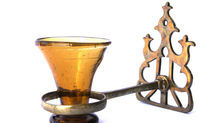The symbolic images of the Twelve Tribes of Israel
- Shira Batalin
- Mar 7, 2021
- 1 min read
The symbolic motif of the Twelve Tribes of Israel was most common in the Jewish art tradition, and was based on Torah verses and Midrashim. For example, in the 17th century, the symbols of the twelve tribes first appear in Haggadot and in Jewish marriage contracts (Ketubot) from northern Italy.
At the end of the 19th century, as part of a process in which the Zionist movement sought to create a new Jewish culture, the symbols of the twelve tribes were used to express the fulfillment of redemption through Zionism. The messianic ideas associated with these symbols in the diaspora underwent a process of secularization and were realized in the Land of Israel.
The first attempts to represent Zionist ideas on the land of Israel in the visual field were created at the Bezalel School of Art and Craft, founded in Jerusalem in 1906. At that time the symbols of the twelve tribes were resumed and placed in the first line of the founding symbols in the renewed Israeli being.
Thus, for example, on decorative plates from the first half of the 20th century, the symbol of the tribe of Reuven is described by means of a sun shining above the sea; the symbols of Shim'on and Levi are united and symbolized by the sword; Ephraim and Menashe are depicted in symbols that represent the Land of Israel - one using a vine and the other using a palm tree.
In this way, the plates constitute an example of the new Jewish art - a Jewish-Zionist-Israeli art at that crucial time in the consolidation of the new national identity and the realization of the Land of Israel.


































コメント